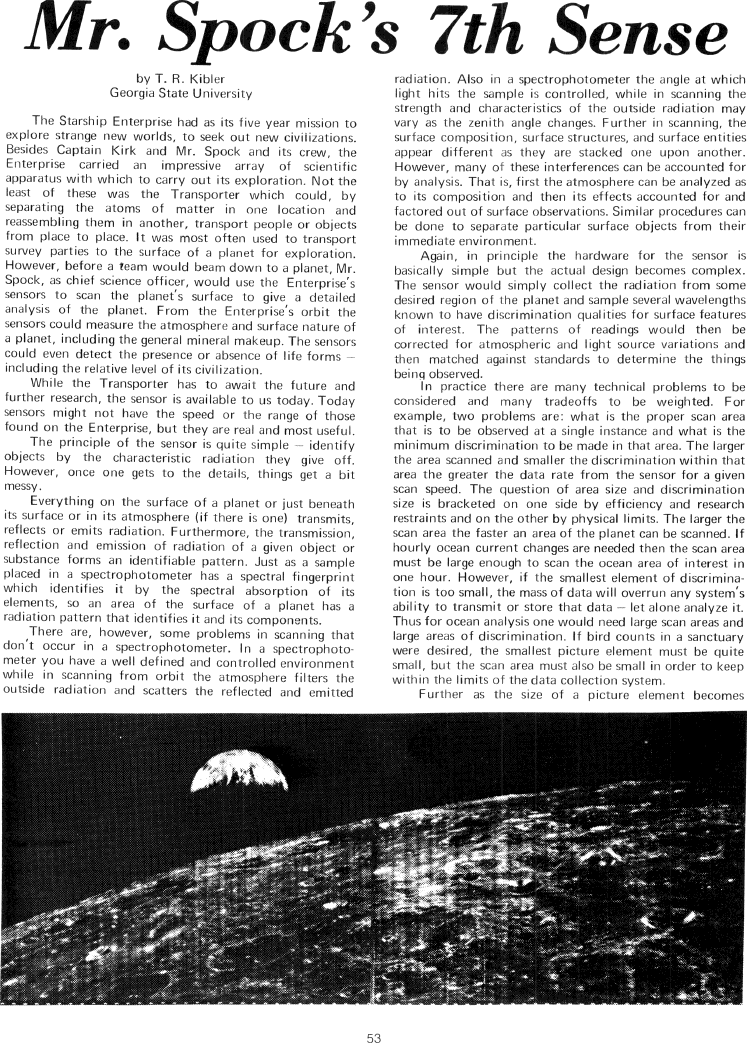The Best of Creative Computing Volume 1 (published 1976)
Mr. Spock's 7th Sense (long-distance sensors on Star Trek's Starship Enterprise)

Mr. Spock's 7th Sense
by T. R. Kibler
Georgia State University
The Starship Enterprise had as its five year mission to explore strange new
worlds, to seek out new civilizations. Besides Captain Kirk and Mr. Spock and
its crew, the Enterprise carried an impressive array of scientific apparatus
with which to carry out its exploration. Not the least of these was the
Transporter which could, by separating the atoms of matter in one location and
reassembling them in another, transport people or objects from place to place.
It was most often used to transport survey parties to the surface of a planet
for exploration. However, before a team would beam down to a planet, Mr. Spock,
as chief science officer, would use the Enterprise's sensors to scan the
planet's surface to give a detailed analysis of the planet. From the
Enterprise's orbit the sensors could measure the atmosphere and surface nature
of a planet, including the general mineral makeup. The sensors could even detect
the presence or absence of life forms -including the relative level of its
civilization.
While the Transporter has to await the future and further research, the sensor
is available to us today. Today sensors might not have the speed or the range of
those found on the Enterprise, but they are real and most useful.
The principle of the sensor is quite simple - identify objects by the
characteristic radiation they give off. However, once one gets to the details,
things get a bit messy.
Everything on the surface of a planet or just beneath its surface or in its
atmosphere (if there is one) transmits, reflects or emits radiation.
Furthermore, the transmission, reflection and emission of radiation of a given
object or substance forms an identifiable pattern. Just as a sample placed in a
spectrophotometer has a spectral fingerprint which identifies it by the spectral
absorption of its elements, so an area of the surface of a planet has a
radiation pattern that identifies it and its components.
There are, however, some problems in scanning that don't occur in a
spectrophotometer. In a spectrophotometer you have a well defined and controlled
environment while in scanning from orbit the atmosphere filters the outside
radiation and scatters the reflected and emitted radiation. Also in a
spectrophotometer the angle at which light hits the sample is controlled, while
in scanning the strength and characteristics of the outside radiation may vary
as the zenith angle changes. Further in scanning, the surface composition,
surface structures, and surface entities appear different as they are stacked
one upon another. However, many of these interferences can be accounted for by
analysis. That is, first the atmosphere can be analyzed as to its composition
and then its effects accounted for and factored out of surface observations.
Similar procedures can be done to separate particular surface objects from their
immediate environment.
Again, in principle the hardware for the sensor is basically simple but the
actual design becomes complex. The sensor would simply collect the radiation
from some desired region of the planet and sample several wavelengths known to
have discrimination qualities for surface features of interest. The patterns of
readings would then be corrected for atmospheric and light source variations and
then matched against standards to determine the things being observed.
In practice there are many technical problems to be considered and many
tradeoffs to be weighted. For example, two problems are: what is the proper scan
area that is to be observed at a single instance and what is the minimum
discrimination to be made in that area. The larger the area scanned and smaller
the discrimination within that area the greater the data rate from the sensor
for a given scan speed. The question of area size and discrimination size is
bracketed on one side by efficiency and research restraints and on the other by
physical limits. The larger the scan area the faster an area of the planet can
be scanned. If hourly ocean current changes are needed then the scan area must
be large enough to scan the ocean area of interest in one hour. However, if the
smallest element of discrimination is too small, the mass of data will overrun
any system's ability to transmit or store that data - let alone analyze it. Thus
for ocean analysis one would need large scan areas and large areas of
discrimination. If bird counts in a sanctuary were desired, the smallest picture
element must be quite small, but the scan area must also be small in order to
keep within the limits of the data collection system.
Further as the size of a picture element becomes
53


